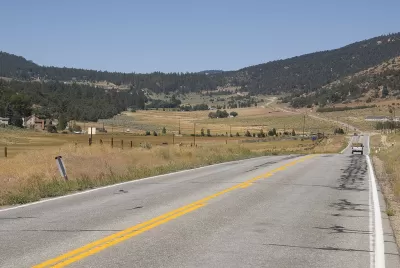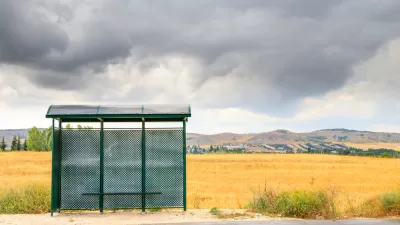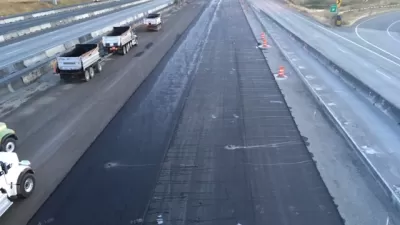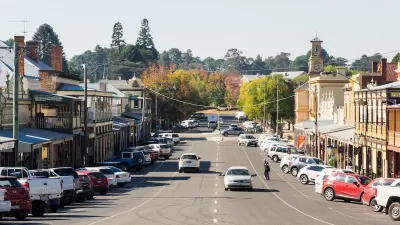Despite the reputation of rural America as "drive-through country," many residents depend on walking and transit to get around.

A new report argues for the urgent need for sustainable public transportation options in rural communities. But, according to Kea Wilson, "the federal politicians who govern them are stonewalling the very legislation that could give it to them, like President Biden’s Build Back Better Act."
The study from Smart Growth America and Third Way found that rural commutes have risen by 15 minutes in 16 years, "thanks in part to increasing consolidation in large employers and the continued proliferation of car-centric transportation planning in their communities." Meanwhile, "[s]hopping trips are 14 percent longer, and the average social or recreational trip has swelled from just over 16 miles at the turn of the century to nearly 18 miles." This adds up to car trips that were 41 percent longer in 2017 than in 2001.
This phenomenon, the report's authors say, is "more avoidable than we might assume." Even in rural areas, it's possible for people to access everyday needs without a car. But many rural legislators oppose legislation that would create better public transit in their regions, viewing rural America as "drive-through country." The report points out that "in reality, the majority of U.S. counties in which 10 percent or more of the population are living without access to a car are rural." rural America, the authors say, has more density than urbanites imagine. "Making those dense centers actually accessible to people on foot, though, can be a challenge, particularly in communities where the town 'main street' is a highway."
The authors call for state leaders to prioritize pedestrian infrastructure and safety, while suggesting that the federal can pave the way for improved rural infrastructure by "revising outdated manuals used by transportation agencies to design streets, including in the Manual on Uniform Traffic Control Devices (MUTCD), and reframing them and removing standards and guidance that lead to streets that are hostile to or dangerous for those outside of a vehicle." The report also recommends a series of other reforms, including more robust data and investment in transit, which advocates hope the Build Back Better plan can deliver.
FULL STORY: Study: Rural Areas Need Safe, Sustainable Transportation Now

Maui's Vacation Rental Debate Turns Ugly
Verbal attacks, misinformation campaigns and fistfights plague a high-stakes debate to convert thousands of vacation rentals into long-term housing.

Planetizen Federal Action Tracker
A weekly monitor of how Trump’s orders and actions are impacting planners and planning in America.

San Francisco Suspends Traffic Calming Amidst Record Deaths
Citing “a challenging fiscal landscape,” the city will cease the program on the heels of 42 traffic deaths, including 24 pedestrians.

Defunct Pittsburgh Power Plant to Become Residential Tower
A decommissioned steam heat plant will be redeveloped into almost 100 affordable housing units.

Trump Prompts Restructuring of Transportation Research Board in “Unprecedented Overreach”
The TRB has eliminated more than half of its committees including those focused on climate, equity, and cities.

Amtrak Rolls Out New Orleans to Alabama “Mardi Gras” Train
The new service will operate morning and evening departures between Mobile and New Orleans.
Urban Design for Planners 1: Software Tools
This six-course series explores essential urban design concepts using open source software and equips planners with the tools they need to participate fully in the urban design process.
Planning for Universal Design
Learn the tools for implementing Universal Design in planning regulations.
Heyer Gruel & Associates PA
JM Goldson LLC
Custer County Colorado
City of Camden Redevelopment Agency
City of Astoria
Transportation Research & Education Center (TREC) at Portland State University
Jefferson Parish Government
Camden Redevelopment Agency
City of Claremont





























